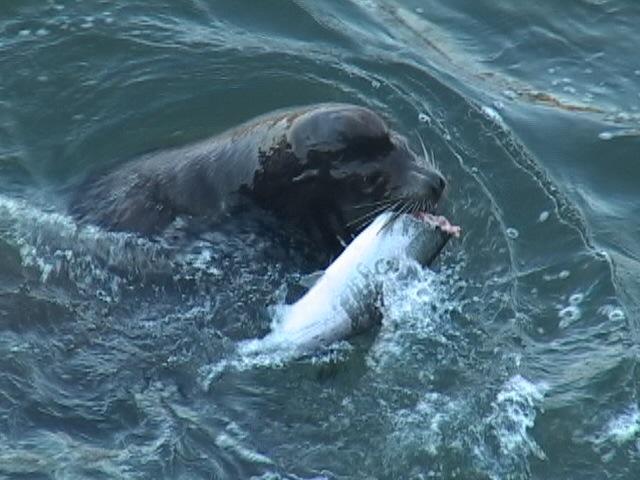
New research suggests sea lions are eating more salmon in the Columbia River than previously thought.
Courtesy of Oregon Department of Fish and Wildlife
PORTLAND -- New research suggests sea lions are eating more salmon in the Columbia River than previously thought.
Data from tracking salmon over the past five years show a significant drop in survival below Bonneville Dam. Michelle Rub, a researcher with with the Northwest Fisheries Science Center, says preliminary numbers show survival dropping from 90 percent in 2010 to 55 percent in 2014.
Meanwhile, she says, the number of sea lions observed in the lower river has jumped from an average of 80 in 2010 to 616 this year.
"We have some pretty alarming survival estimates – particularly in the last couple of years," Rub said. "It's probably not a coincidence that as mortality is increasing, these sea lion numbers have just exploded."
Connecting Sea Lions To Salmon Losses
The research also shows fewer returning salmon are surviving during the months when sea lion numbers are at their peak, in March and April. The data suggests sea lion predation could theoretically be killing an estimated 22,500-57,000 Columbia River salmon.
Robin Brown, marine mammal program leader for the Oregon Department of Fish and Wildlife, says he questions the higher end of that range.
He says the number of sea lions in the Columbia is now three or four times what was observed in the past because of an increase in smelt runs. But he says Rub's research misrepresents the number of sea lions observed in the lower river.
He also notes that the findings don't link the salmon losses directly to sea lions.
"We know some of those fish are lost to pinniped predation, but we don't know that all of these fish were lost to pinniped predation," he said. "There may be a correlation there but there's not necessarily causation."
Brown's agency has helped track sea lion predation at Bonneville Dam on the Columbia and Willamette Falls on its biggest Oregon tributary, the Willamette. Based on those numbers, he's made conservative estimates that sea lions could be eating 16-20 percent of salmon throughout the lower Columbia or around 12,000-20,000 fish.
"We know there's far more pinniped predation on salmon than you could ever report at the face of Bonneville Dam or Willamette Falls," he said. "But that total is kind of an unknown at this point."
Physical Evidence Will Test Theory
ODFW is planning to test sea lion scat this spring to get a better idea of how much salmon sea lions are eating in the lower river.
"If these animals were really consuming 30,000, 40,000, 50,000 salmon over March, April, May, we should find clear and abundant salmon consumption in those fecal samples in the spring," he said.
Rub says she's advising people to focus on the trends revealed by her research rather than the specific numbers, which are subject to a lot of variables.
"It's really hard to get a direct predation estimate," Rub said. "It's mostly building a circumstantial case that, 'Hey, this is the number of fish dropping out of our samples; this is where they seem to be falling out, and oh, by the way this is where the bulk of the seals and sea lions are.'"
Rub says she's hoping to work with agencies that track tagged sea lions to see if salmon losses can be more directly tied to known sea lion locations.
She says the findings so far are significant because they document salmon mortality below Bonneville Dam. In the past, Bonneville has been the first checkpoint for salmon marked with tracking tags, and researchers haven't counted how many salmon die on the way there. The new research indicates there may be more fish coming back to the river than what's counted at Bonneville.

